声明:本文参考自:https://www.cnblogs.com/cunkouzh/p/9242292.html
:https://blog.csdn.net/liguangyan_neu/article/details/78027105
:https://blog.csdn.net/u014513883/article/details/77036890?locationNum=9&fps=1
本文主要是通过在windows环境上搭建一个本机的集群环境
1.先配置服务器(本地)哨兵模式,直接从redis官网下载安装或者解压版,安装后的目录结构
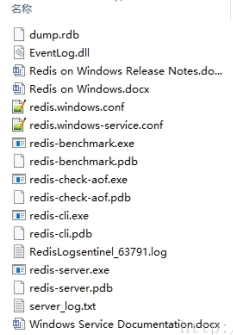
然后配置哨兵模式
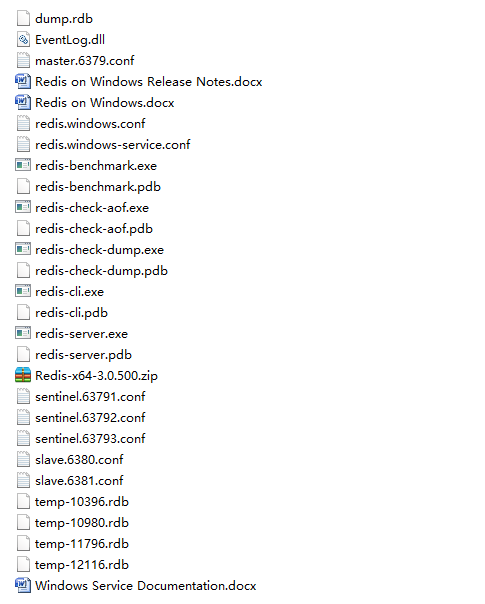
配置master.6379.conf
port:6379 #设置连接密码 requirepass:grs #密码可以不设置,如果设置了密码,两个从机也要做相同的配置 #连接密码 masterauth:grs #密码可以不设置,如果设置了密码,两个从机也要做相同的配置
slave.6380.conf配置
port:6380 dbfilename dump6380.rdb
requirepass:grs #如果主机进行了密码配置,则从机也要做相同配置
#连接密码
masterauth:grs #如果主机进行了密码配置,则从机也要做相同配置
#配置master
slaveof 127.0.0.1 6379
slave.6381.conf配置
port 6381
requirepass:grs #如果主机进行了密码配置,则从机也要做相同配置 #连接密码 masterauth:grs #如果主机进行了密码配置,则从机也要做相同配置
slaveof 127.0.0.1 6379 dbfilename dump6381.rdb
配置哨兵sentinel.63791.conf(其他两个哨兵配置文件一致,只修改端口号码即可)
port 63791 #主master,2个sentinel选举成功后才有效,这里的master-1是名称,在整合的时候需要一致,这里可以随便更改 sentinel monitor master-1 127.0.0.1 6379 2 #判断主master的挂机时间(毫秒),超时未返回正确信息后标记为sdown状态 sentinel down-after-milliseconds master-1 5000 #若sentinel在该配置值内未能完成failover操作(即故障时master/slave自动切换),则认为本次failover失败。 sentinel failover-timeout master-1 18000 #选项指定了在执行故障转移时, 最多可以有多少个从服务器同时对新的主服务器进行同步,这个数字越小,完成故障转移所需的时间就越长 sentinel config-epoch master-1 2
需要注意的地方
1、若通过redis-cli -h 127.0.0.1 -p 6379连接,无需改变配置文件,配置文件默认配置为bind 127.0.0.1(只允许127.0.0.1连接访问)若通过redis-cli -h 192.168.180.78 -p 6379连接,需改变配置文件,配置信息为bind 127.0.0.1 192.168.180.78(只允许127.0.0.1和192.168.180.78访问)或者将bind 127.0.0.1注释掉(允许所有远程访问)
2、masterauth为所要连接的master服务器的requirepass,如果一个redis集群中有一个master服务器,两个slave服务器,当master服务器挂掉时,sentinel哨兵会随机选择一个slave服务器充当master服务器,鉴于这种机制,解决办法是将所有的主从服务器的requirepass和masterauth都设置为一样。
3、sentinel monitor master-1 127.0.0.1 6379 2 行尾最后的一个2代表什么意思呢?我们知道,网络是不可靠的,有时候一个sentinel会因为网络堵塞而误以为一个master redis已经死掉了,当sentinel集群式,解决这个问题的方法就变得很简单,只需要多个sentinel互相沟通来确认某个master是否真的死了,这个2代表,当集群中有2个sentinel认为master死了时,才能真正认为该master已经不可用了。(sentinel集群中各个sentinel也有互相通信,通过gossip协议)。
依次启动redis
redis-server master.6379.conf(如果设置了密码,需要使用auth grs(你的密码) 在连接后进行验证)
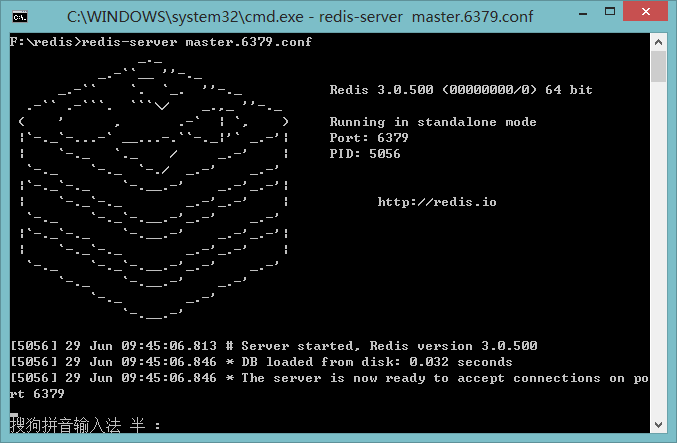
redis-server slave.6380.conf
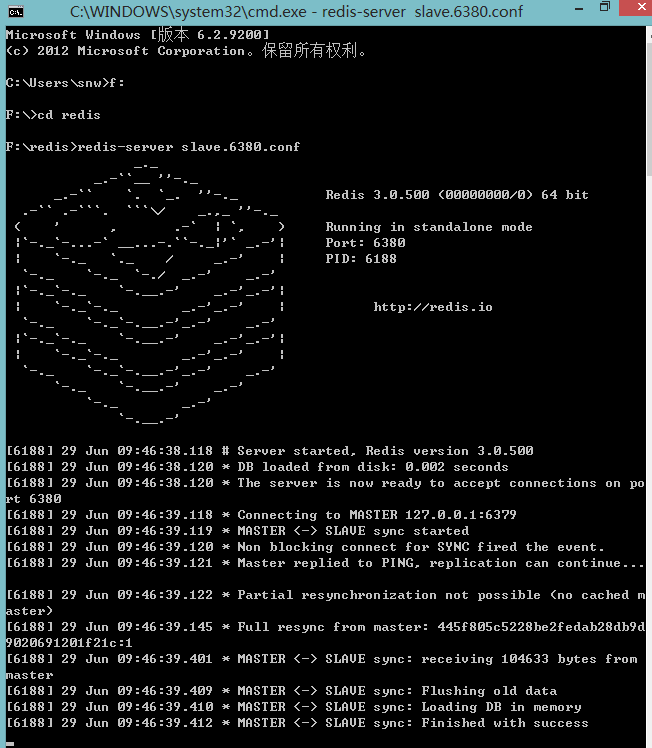
redis-server slave.6381.conf
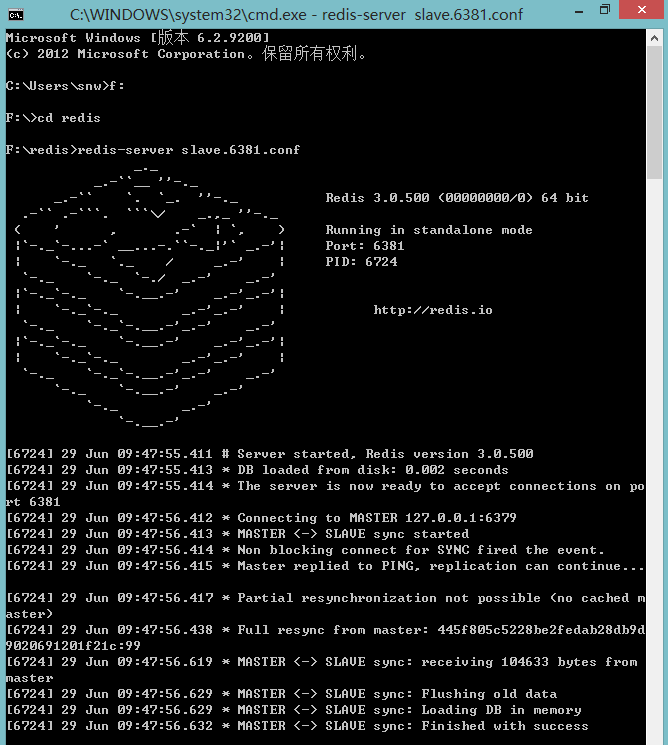
redis-server sentinel.63791.conf --sentinel(linux:redis-sentinel sentinel.63791.conf)其他两个哨兵也这样启动

使用客户端查看一下master状态
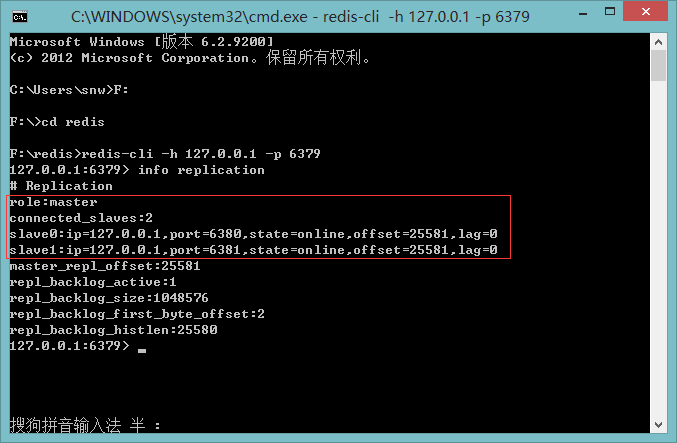
查看一下哨兵状态
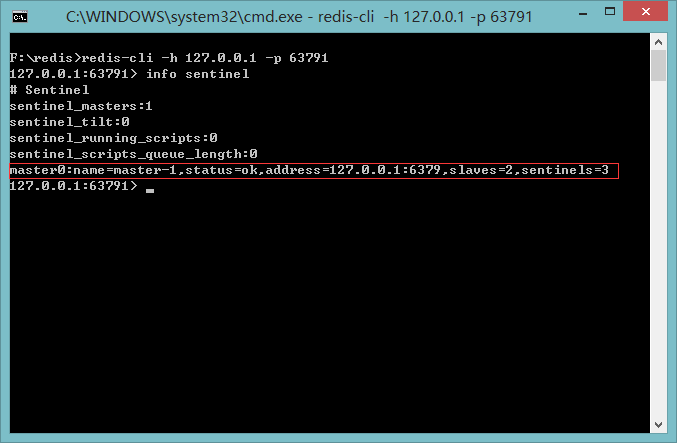
现在就可以在master插入数据,所有的redis服务都可以获取到,slave只能读
整合spring,导入依赖
<dependency> <groupId>redis.clients</groupId> <artifactId>jedis</artifactId> <version>2.8.0</version> </dependency> <!-- spring-redis --> <dependency> <groupId>org.springframework.data</groupId> <artifactId>spring-data-redis</artifactId> <version>1.6.4.RELEASE</version> </dependency> <dependency> <groupId>org.apache.commons</groupId> <artifactId>commons-pool2</artifactId> <version>2.4.2</version> </dependency>
redis.properties
#redis中心 redis.host=127.0.0.1 #redis.host=10.75.202.11 redis.port=6379 redis.password= #redis.password=123456 redis.maxTotal=200 redis.maxIdle=100 redis.minIdle=8 redis.maxWaitMillis=100000 redis.maxActive=300 redis.testOnBorrow=true redis.testOnReturn=true #Idle时进行连接扫描 redis.testWhileIdle=true #表示idle object evitor两次扫描之间要sleep的毫秒数 redis.timeBetweenEvictionRunsMillis=30000 #表示idle object evitor每次扫描的最多的对象数 redis.numTestsPerEvictionRun=10 #表示一个对象至少停留在idle状态的最短时间,然后才能被idle object evitor扫描并驱逐;这一项只有在timeBetweenEvictionRunsMillis大于0时才有意义 redis.minEvictableIdleTimeMillis=60000 redis.timeout=100000
配置sentinel方式一
<!-- 这个这个bean是继承RedisSentinelConfiguration,原因是我直接使用时,在注入哨兵的时候spring获取不到注入属性的方法,老是报参数异常 --> <bean id="redisSentinelConfiguration" class="com.uec.village.redis.RedisConfiguration"><!-- 这里是配置哨兵模式 --> <constructor-arg name="sentinels"> <set> <bean class="org.springframework.data.redis.connection.RedisNode"> <constructor-arg name="host" value="${redis.host}"/> <constructor-arg name="port" value="63791"/> </bean> <bean class="org.springframework.data.redis.connection.RedisNode"> <constructor-arg name="host" value="${redis.host}"/> <constructor-arg name="port" value="63792"/> </bean> <bean class="org.springframework.data.redis.connection.RedisNode"> <constructor-arg name="host" value="${redis.host}"/> <constructor-arg name="port" value="63793"/> </bean> </set> </constructor-arg> <property name="master"> <bean class="org.springframework.data.redis.connection.RedisNode"> <!--必须指定主节点名称,与服务中的master名称一致--> <property name="name" value="master-1"/> <!-- <constructor-arg name="host" value="${redis.host}"/> --> <!-- <constructor-arg name="port" value="6379"/> --> </bean> </property> </bean><!-- 可以直接配置sentinel --> <!-- <bean id="redisSentinelConfiguration" class="org.springframework.data.redis.connection.RedisSentinelConfiguration"> <property name="sentinels"> <set> <bean name="sentinelNode1" class="org.springframework.data.redis.connection.RedisNode"> <constructor-arg name="host" value="${redis.host}"/> <constructor-arg name="port" value="63791"/> </bean> <bean name="sentinelNode2" class="org.springframework.data.redis.connection.RedisNode"> <constructor-arg name="host" value="${redis.host}"/> <constructor-arg name="port" value="63792"/> </bean> <bean name="sentinelNode3" class="org.springframework.data.redis.connection.RedisNode"> <constructor-arg name="host" value="${redis.host}"/> <constructor-arg name="port" value="63793"/> </bean> </set> </property> <property name="master"> <bean name="masterNode" class="org.springframework.data.redis.connection.RedisNode"> <!--必须指定主节点名称--> <property name="name" value="mymaster"/> <!-- <constructor-arg name="host" value="${redis.host}"/> <constructor-arg name="port" value="6379"/> --> </bean> </property> </bean> -->
配置sentinel方式二
<bean id="redisSentinelConfiguration" class="org.springframework.data.redis.connection.RedisSentinelConfiguration"> <constructor-arg name="propertySource" ref="propertySource"/> </bean> <bean name="propertySource" class="org.springframework.core.io.support.ResourcePropertySource"> <constructor-arg name="location" value="classpath:spring-redis-sentinel.properties" /> </bean>
spring-redis-sentinel.properties内容:
#哨兵监控主redis节点名称,必选 spring.redis.sentinel.master=mymaster #哨兵节点 spring.redis.sentinel.nodes=192.168.48.31:26379,192.168.48.32:26379,192.168.48.33:26379
xml配置
<!-- jedis 配置 --> <bean id="poolConfig" class="redis.clients.jedis.JedisPoolConfig" > <property name="maxTotal" value="${redis.maxTotal}" /> <property name="maxIdle" value="${redis.maxIdle}" /> <property name="minIdle" value="${redis.minIdle}" /> <property name="maxWaitMillis" value="${redis.maxWaitMillis}" /> <property name="testOnBorrow" value="${redis.testOnBorrow}" /> <property name="testOnReturn" value="${redis.testOnReturn}" /> <property name="testWhileIdle" value="${redis.testWhileIdle}" /> <property name="timeBetweenEvictionRunsMillis" value="${redis.timeBetweenEvictionRunsMillis}" /> <property name="numTestsPerEvictionRun" value="${redis.numTestsPerEvictionRun}" /> <property name="minEvictableIdleTimeMillis" value="${redis.minEvictableIdleTimeMillis}" /> </bean > <!-- redis服务器中心 --> <bean id="connectionFactory" class="org.springframework.data.redis.connection.jedis.JedisConnectionFactory" > <constructor-arg name="sentinelConfig" ref="redisSentinelConfiguration"/> <constructor-arg name="poolConfig" ref="poolConfig" /> <!-- <property name="poolConfig" ref="poolConfig" /> 如果不是哨兵模式,把这行放开,注释掉上面两行的构造方法注入--> <property name="port" value="${redis.port}" /> <property name="hostName" value="${redis.host}" /> <property name="password" value="${redis.password}" /> <property name="timeout" value="${redis.timeout}" ></property> </bean > <bean id="redisTemplate" class="org.springframework.data.redis.core.RedisTemplate" > <property name="connectionFactory" ref="connectionFactory" /> <property name="keySerializer" > <bean class="org.springframework.data.redis.serializer.StringRedisSerializer" /> </property> <property name="valueSerializer" > <bean class="org.springframework.data.redis.serializer.JdkSerializationRedisSerializer" /> </property> </bean > <!-- cache配置 --> <bean id="redisUtil" class="com.uec.village.util.RedisUtil" > <property name="redisTemplate" ref="redisTemplate" /> </bean > <bean id="methodCacheInterceptor" class="com.uec.village.interceptor.MethodCacheInterceptor" > <property name="redisUtil" ref="redisUtil" /> </bean > <!-- 配置拦截需要缓存的方法,根绝注解决定 --> <bean id="methodCachePointCut" class="org.springframework.aop.support.RegexpMethodPointcutAdvisor" > <property name="advice" > <ref local="methodCacheInterceptor" /> </property> <property name="patterns" > <set> <!-- 确定正则表达式列表 --> <value>com.service.impl...*ServiceImpl.*</value > </set> </property> </bean >
RedisConfiguration类
import static org.springframework.util.Assert.notNull; import java.util.Set; import org.springframework.data.redis.connection.RedisNode; import org.springframework.data.redis.connection.RedisSentinelConfiguration; public class RedisConfiguration extends RedisSentinelConfiguration{ public RedisConfiguration(){} public RedisConfiguration(Iterable<RedisNode> sentinels){ notNull(sentinels, "Cannot set sentinels to 'null'."); Set<RedisNode> sentinels2 = getSentinels(); if(!sentinels2.isEmpty()){ sentinels2.clear(); } for (RedisNode sentinel : sentinels) { addSentinel(sentinel); } } }
MethodCacheInterceptor拦截器
import java.lang.reflect.Method; import org.aopalliance.intercept.MethodInterceptor; import org.aopalliance.intercept.MethodInvocation; import com.uec.village.annotation.RedisCache; import com.uec.village.util.RedisUtil; /** * 用户登录过滤器 * @author snw * */ public class MethodCacheInterceptor implements MethodInterceptor { private RedisUtil redisUtil; /** * 初始化读取不需要加入缓存的类名和方法名称 */ public MethodCacheInterceptor() { } @Override public Object invoke(MethodInvocation invocation) throws Throwable { Object value = null; String targetName = invocation.getThis().getClass().getName(); Method method = invocation.getMethod(); String methodName = method.getName(); RedisCache annotation = method.getAnnotation(RedisCache.class); //说明当前方法不需要缓存的, if(annotation == null){ return invocation.proceed(); } Object[] arguments = invocation.getArguments(); String key = getCacheKey(targetName, methodName, arguments); System.out.println(key); try { // 判断是否有缓存 if (redisUtil.exists(key)) { System.out.println("方法名称为:"+methodName+",根据:"+key+",从缓存中获取"); return redisUtil.get(key); } // 写入缓存 value = invocation.proceed(); if (value != null) { final String tkey = key; final Object tvalue = value; if(annotation.isTime()){ redisUtil.set(tkey, tvalue); } } return value; } catch (Exception e) { e.printStackTrace(); if (value == null) { return invocation.proceed(); } } return value; } /** * 创建缓存key * * @param targetName * @param methodName * @param arguments */ private String getCacheKey(String targetName, String methodName, Object[] arguments) { StringBuffer sbu = new StringBuffer(); sbu.append(targetName).append("_").append(methodName); if ((arguments != null) && (arguments.length != 0)) { for (int i = 0; i < arguments.length; i++) { sbu.append("_").append(arguments[i]); } } return sbu.toString(); } public void setRedisUtil(RedisUtil redisUtil) { this.redisUtil = redisUtil; } }
redis工具类
import java.io.Serializable; import java.util.Set; import java.util.concurrent.TimeUnit; import org.springframework.data.redis.core.RedisTemplate; import org.springframework.data.redis.core.ValueOperations; /** * redis工具 * @author snw * */ public class RedisUtil { private RedisTemplate<Serializable, Object> redisTemplate; /** * 批量删除对应的value * * @param keys */ public void remove(final String... keys) { for (String key : keys) { remove(key); } } /** * 批量删除key * * @param pattern */ public void removePattern(final String pattern) { Set<Serializable> keys = redisTemplate.keys(pattern); if (keys.size() > 0) redisTemplate.delete(keys); } /** * 删除对应的value * * @param key */ public void remove(final String key) { if (exists(key)) { redisTemplate.delete(key); } } /** * 判断缓存中是否有对应的value * * @param key * @return */ public boolean exists(final String key) { return redisTemplate.hasKey(key); } /** * 读取缓存 * * @param key * @return */ public Object get(final String key) { Object result = null; ValueOperations<Serializable, Object> operations = redisTemplate .opsForValue(); result = operations.get(key); return result; } /** * 写入缓存 * * @param key * @param value * @return */ public boolean set(final String key, Object value) { boolean result = false; try { ValueOperations<Serializable, Object> operations = redisTemplate .opsForValue(); operations.set(key, value); result = true; } catch (Exception e) { e.printStackTrace(); } return result; } /** * 写入缓存 * * @param key * @param value * @return */ public boolean set(final String key, Object value, Long expireTime) { boolean result = false; try { ValueOperations<Serializable, Object> operations = redisTemplate .opsForValue(); operations.set(key, value); redisTemplate.expire(key, expireTime, TimeUnit.SECONDS); result = true; } catch (Exception e) { e.printStackTrace(); } return result; } public void setRedisTemplate( RedisTemplate<Serializable, Object> redisTemplate) { this.redisTemplate = redisTemplate; } }
自定义注解
import java.lang.annotation.ElementType; import java.lang.annotation.Retention; import java.lang.annotation.RetentionPolicy; import java.lang.annotation.Target; @Target(ElementType.METHOD) @Retention(RetentionPolicy.RUNTIME) public @interface RedisCache { boolean isCache() default false; }
到这里可以测试一下,你缓存的数据,是否可以直接使用客户端获取。如有不对的地方欢迎大家扔鸡蛋,以免误人子弟,谢谢!